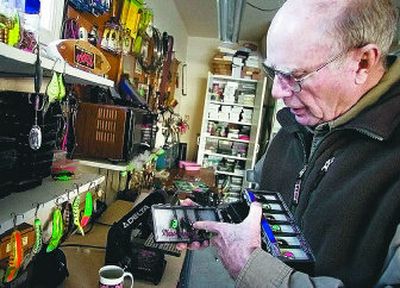What makes lures work?

VANCOUVER — Phil Rabideau wastes no time in the sporting goods store aisle that’s packed with a plethora of fish-attracting scents.
Nor does he bother with any rattling lures in his tackle box.
Rabideau, 79, of Vancouver, is an electrical engineer. After years of studying the physiology and behavior of fish, experiencing the vagarities of fishing, and applying engineering methodology, Rabideau has come to this conclusion: lure color, contrast and brightness — linked to water temperature — are the keys to getting fish to strike.
His beliefs are detailed in his book “The Master Angler” (Hancock House, 94 pages, $14.95).
Anglers are notorious in their pursuit of the “hot lure,” Rabideau said.
“There are so many various conditions when you’re out fishing that the hot lure ends up being a cold turkey,” he said. “That’s why the poor fishermen have three or four tackle boxes. They have so many lures but only use a few of them on a given day. If you blindfolded yourself, and reached into your tackle box, there’d be a 3 percent chance of selecting the right lure.”
Sight is a vastly more important foraging sense for fish than smell or sound, Rabideau said.
Fish do not sense direction of smell, he said.
“If you put a scented bait or milk overboard in a lake, it’s just a bunch of clouds of smell, strong here, weak here and void here,” Rabideau said. “They can’t track on smell. … The only place where you can make a case for smell being an attractant is in a river, because the smell is going down the river.”
He also discounts the importance of sound.
“A lot of baits, manufacturers put rattles in them,” he said. “It makes absolutely no sense because that is a high-frequency noise, and fish are not attuned to high frequencies. You’re wasting your money buying fish lures that rattle, yet you see tons of them in the catalog.”
Matching lure color, brightness and contrast to water temperature is the key to fishing, he said.
Various fish species have optimum water temperature ranges, which Rabideau lists in his book. He classifies the optimum range as “cool.” Below optimum is labeled “cold” and above optimum as “warm.”
Water color also can range from blue to green to turbid, which also makes a difference in lure choice.
“Every lure color combination has a narrow band where it’s effective,” he said.
“When it’s (the water) cold, it takes a lot to excite them,” Rabideau said. “That’s when the silvers and the real bright lures will excite a fish. When it warms up to the cool range, then you’ve got to tone down to less bright colors.”
In blue water, a lot of colors work, he said. In green water, silver, fluorescent red or orange and chartreuse are good. In muddy water, try a combination of gold, chartreuse and black.
Fluorscent orange lures in turbid water look tan, almost the color of the water.
Rabideau also is death on camouflaged lures.
“You don’t want your lure to take on the camouflaging of the bait,” he said. “Why would you want to camouflage a lure or bait so fish can’t see it. I want my lures to be killed by the fish.
“You want to get away from lures that are decorated like a fish. The only reason they do that is to sell the lures to the fishermen, because he thinks whatever he uses has to look like a bait fish.”